#Artur Axmann
Text
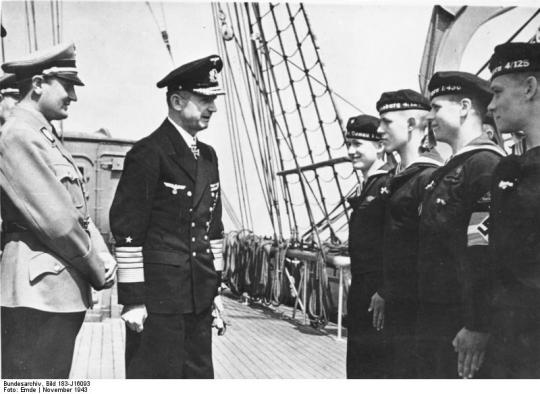
Kriegsmarine (German navy) Großadmiral Karl Dönitz (second from left) and Reichsjugendführer Artur Axmann with Hitler Jugend sailors aboard training vessel Horst Wessel, Nov 1943
11 notes
·
View notes
Photo

Bad movie I have And Now for Something Completely Different 1971
#And Now for Something Completely Different#Playboy Productions#Graham Chapman#John Cleese#Terry Gilliam#Eric Idle#Terry Jones#Michael Palin#Carol Cleveland#Connie Booth#Lewis Alexander#Artur Axmann#Rodney Cardiff#Neville Chamberlain#Winston Churchill#Adolf Hitler#Lesley Judd#King George VI#Roy Lansford#Richard Nixon#Harry Phipps#Monty Python#Queen Elizabeth#Fred Wood
3 notes
·
View notes
Text
Baldur von Schirach
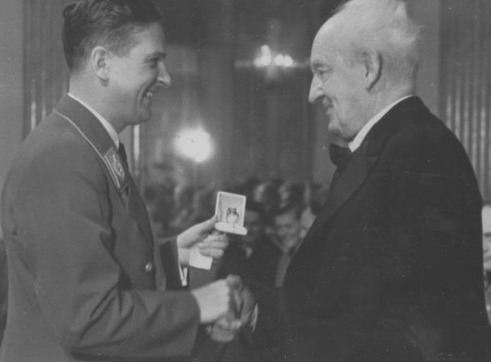
These are some facts and curiosities about Baldur von Schirach, the head of the Hitler Youth:
He was born in Berlin, the youngest of four children of theatre director Rittmeister Carl Baily Norris von Schirach.
Through his mother, Schirach descended from two signatories of the United States Declaration of Independence.
On 31 March 1932 von Schirach married 19-year-old Henriette Hoffmann, the daughter of Heinrich Hoffmann, Adolf Hitler's personal photographer and close friend. Von Schirach's family was vehemently opposed to the marriage to Henriette, but Hitler insisted
He joined a Wehrjugendgruppe (military cadet group) at the age of 10 and became a member of the Nazi Party (NSDAP) in 1925.
He was named Reichsjugendführer (Youth Leader) of the NSDAP in 1931, and in 1933 he was made head of the Hitler Youth (Hitler-Jugend) and given an SA rank of Gruppenführer.
He set the militaristic tone for the youth organisation, and they participated in military style exercises, as well as practising use of military equipment, such as rifles.
He lost control of the Hitler Youth to Artur Axmann, and was appointed Governor (Gauleiter or Reichsstatthalter) of the Reichsgau Vienna, a post in which he remained until the end of the war. He was an anti-Semite and an anti-Christian.
During his tenure 65,000 Jews were deported from Vienna to Poland, and in a speech on 15 September 1942 he mentioned their deportation as a "contribution to European culture''
He was notoriously anxious about air raids.
Schirach surrendered in 1945 and was one of the officials put on trial at Nuremberg.
He was found guilty on 1 October 1946 of crimes against humanity for his role in the deportation of the Viennese Jews to certain death in Poland. He was sentenced and served 20 years as a prisoner in Spandau Prison, Berlin.
He died on 8 August 1974 in Kröv.
He and Henriette had four children:
Angelika von Schirach 1933-
Klaus von Schirach: 1935-
Robert von Schirach: 1938-
Richard von Schirach: 1942-
Sources:
Military Wiki: Baldur von Schirach
Wikipedia: Baldur von Schirach
❗❗I DON'T SUPPORT NAZISM,FASCISM OR ZIONISM IN ANY WAY, THIS IS AN EDUCATIONAL POST❗❗
18 notes
·
View notes
Text
Conspiracy Theory Time: Hitler didn’t die in the bunker
Check out this screen shot. It’s a common image, there’s video available, and it’s supposedly some of the last if not the last image of Hitler. That appears to be Artur Axmann, the man standing next to/behind Hitler and that looks like his prosthetic arm. He lost his arm in 1941 so it was clearly taken no early than that. But it’s dated 1945 and...

And there’s a problem here. Look at the third boy from the right. We see him again:
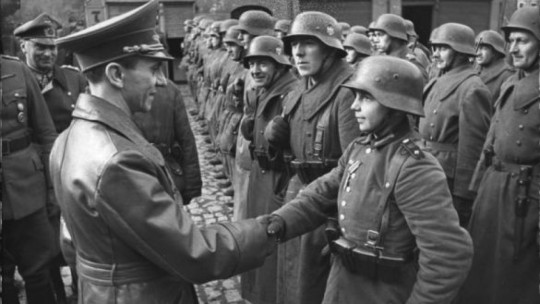
He’s older. And it’s not Hitler whose hand he’s shaking. And to make this official, this second photo was definitely taken in 1945, as were others at the exact same event... Click here <link>
Goebbels supposedly out lived Hitler by like a day. Seriously. A day, according to the official narrative, and the whole area was a crater strewn wasteland before then. So the timelines don’t add up.
WHAT I AM NOT SAYING:
I’m not saying that Hitler escaped to Argentina or flew off in a Nazi built flying saucer. I’m not even saying that he survived the war. My best guess is that he died earlier than the official narrative claims, that he was already dead.. maybe as early as 1943 but probably in 1944. He may not have even survived the July Bomb Plot.
3 notes
·
View notes
Photo






292) Hitlerjugend, Hitler Youth (oficjalnie pisane jako Hitler-Jugend, w skrócie HJ, pol. dosł. „Młodzież Hitlera”) – niemiecka organizacja młodzieżowa NSDAP zorganizowana na wzór paramilitarny w 1922 roku jako przybudówka Oddziałów Szturmowych (SA). Pierwszą organizacją młodzieżową związaną z partią nazistowską była Jugendbund der NSDAP. Utworzona została 8 marca 1922 roku przez Nationalsozialistische Deutsche Arbeiterpartei (NSDAP), a jej inauguracyjne spotkanie odbyło się 13 maja tego samego roku. W kwietniu 1924 roku Jugendbund przemianowano na Grossdeutsche Jugendbewegung (Wielkoniemiecki Ruch Młodzieżowy). Inną młodzieżową grupą założoną w 1922 roku była Jungsturm. Powstała w Monachium, by służyć szkoleniu i rekrutowaniu przyszłych członków SA. Po nieudanym puczu monachijskim w 1923 roku grupy nazistowskiej młodzieży pozornie zostały rozwiązane, jednak w rzeczywistości zeszły do podziemia, gdzie wiele osób działało pod przybranymi imionami. 4 lipca 1926 roku Großdeutsche Jugendbewegung (GDJB) oficjalnie przemianowano na Hitlerjugend, Bund deutscher Arbeiterjugend. Wydarzenie to miało miejsce rok po reorganizacji samej partii nazistowskiej. Architektem głównych przemian był Kurt Gruber, student prawa i wielbiciel Hitlera. Do 1930 roku do Hitlerjugend zwerbowano 25 000 chłopców od 14 lat wzwyż. Wtedy także ustanowiono Deutsches Jungvolk dla chłopców w wieku od 10 do 14. Dziewczęta od 10 do 18 lat mogły wstępować do własnej organizacji Bund Deutscher Mädel. Znaczący rozwój organizacji zaczął się na początku lat 30., kiedy Baldur von Schirach został jej pierwszym przywódcą a znaczne sumy pieniędzy, które na nią przeznaczano przyspieszyły jej dalszy wzrost. 1 grudnia 1936 roku uchwalona została Ustawa o Hitlerjugend (Gesetz über die Hitlerjugend), stwierdzająca, że „Cała niemiecka młodzież z terenu Rzeszy jest skupiona w Hitlerjugend”. Drugie rozporządzenie wykonawcze do Ustawy o Hitler-Jugend, z dn. 25 marca 1939, określało z kolei, że do pełnienia służby w HJ zobowiązani byli wszyscy młodociani Niemcy od 10. do ukończenia 18. roku życia (poza niezdolnymi z przyczyn zdrowotnych czy formalnych), zaś opiekunowie powstrzymujący młodocianych od służby w HJ zagrożeni byli karą grzywny bądź więzienia. W 1940 roku Artur Axmann zastąpił Baldura von Schiracha na stanowisku Reichsjugendführera i przejął dowództwo nad organizacją. Zaczął przekształcać HJ w wojskowe siły pomocnicze, które mogłyby wykonywać zadania zarezerwowane dotychczas dla armii. Wprowadzenie zmian sprawiło, że młodzież zaczęła działać w brygadach strzeleckich, pomagała w zbombardowanych przez aliantów miastach i zajmowała się obroną przeciwlotniczą. W 1943 roku z powodu ogromnych strat wojskowych nazistowscy przywódcy zdecydowali, że HJ zostanie przekształcone w wojskową rezerwę. W tym samym roku utworzono 12 Dywizję Pancerną SS „Hitlerjugend”, pod dowództwem Brigadeführera SS Fritza Witta. Dywizja była w pełni wyposażona, a większość jej żołnierzy stanowili chłopcy w wieku 16–18 lat. W czasie alianckiej inwazji w Normandii wysłano ją na północ Caen, przeciw brytyjskim i kanadyjskim siłom. Po kilku miesiącach zaciętych walk dywizja znana już była z bezwzględności i fanatyzmu. Kiedy Witt zginął, dowództwo przejął Kurt Meyer, który w wieku 33 lat stał się najmłodszym dywizyjnym dowódcą. Pod koniec wojny, kiedy Niemcy ponosili coraz więcej ofiar, a rezerwy były na wyczerpaniu, do HJ wcielano coraz młodsze dzieci. W 1945 roku w szeregach Volkssturmu byli nawet 12-latkowie. Podczas bitwy o Berlin, HJ stanowiła główną część ostatniej linii obrony. Chociaż dowódca obrony miasta, generał Helmuth Weidling, nakazał Axmannowi rozwiązanie bojowych formacji HJ, rozkaz ten nigdy nie został wykonany. Po zakończeniu wojny władze alianckie w ramach denazyfikacji rozwiązały Hitlerjugend, choć sama organizacja nie została uznana za przestępczą. Niektórzy członkowie HJ byli podejrzewani o zbrodnie wojenne, ale ponieważ byli dziećmi, żadne poważne zarzuty nie zostały im postawione. Alianci osądzili za to wielu dowódców HJ, a Baldura von Schiracha skazali na 20 lat więzienia (jednak głównie za zbrodnicze działania, których dopuścił się jako Gauleiter Wiednia, a nie za przywództwo w HJ). W HJ istniał podział na grupy wiekowe:
10–14 lat:
chłopcy jako „Pimpfe” w Deutsches Jungvolk in der HJ (DJ); dziewczynki w Jungmädel in der HJ lub Jungmädelbund in der HJ
14–18 lat:
chłopcy w HJ; dziewczęta w Bund Deutscher Mädel in der HJ, później Mädelbund in der HJ (BDM) – Związek Dziewcząt Niemieckich; wraz z wprowadzeniem BDM-Werk Glaube und Schönheit okres służby w BDM skrócono do 17. roku życia
17–21 lat:
młode kobiety w służbie BDM-Werk Glaube und Schönheit – Wiara i Piękno.
Wychowanie HJ było wzorowane na spartańskiej agoge. Na przełomie 1933 i 1934 roku przywódcy Hitlerjugend zwrócili się również do Związku Harcerstwa Polskiego w Niemczech z żądaniem przystąpienia polskich harcerzy do swojej organizacji jako „autonomiczna grupa mniejszościowa”. W razie odmowy zagrozili rozwiązaniem harcerstwa polskiego na terenach Niemiec. Związek Harcerstwa Polskiego w Niemczech trzykrotnie odmawiał na podobne apele ze strony Hitlerjugend. Od 1936 roku obowiązywała, zaostrzona jeszcze w 1938 roku, ustawa o obowiązkach młodzieży. Zgodnie z nią, każdy chłopiec i każda dziewczynka przyjmowani byli w wieku 10 lat do DJ, a w wieku 14 lat wstępowali do HJ bądź do BDM. NSDAP kreowała się jako partia młodych i dlatego na przywódcę HJ wyznaczony został w 1931 roku 24-letni Baldur von Schirach – Dowódca Młodzieży Rzeszy. Ten kierunek wyrażały artykuły Gregora Strassera Starzy, zróbcie nam miejsce!, a także Baldura von Schiracha: NSDAP – to partia młodzieży!. W latach 1939–1945 członkowie HJ i BDM pełnili wojskową służbę pomocniczą. Hitlerjugend promował kult silnej i zdrowej germańskiej rasy, stąd duży nacisk kładziono na ćwiczenia fizyczne i wojskowe połączone z dyscypliną i kultem jednostki. Jedną z popularnych „gier”, w które na manewrach grali członkowie HJ, był odpowiednik współczesnej gry w zdobywanie flagi. Gra ta zazwyczaj odbywała się bez reguł (poza zakazem zabijania i okaleczania) i kończyła się brutalną bijatyką z udziałem nawet najmłodszych członków HJ. W ten sposób uczono ich odporności na ból i bezwzględności w dążeniu do celu wyznaczonego przez ich dowódców. Dziewczęta przygotowywano do roli niemieckich matek i żon. Kobieta miała być strażniczką rodu, dziedzictwa, rasy i krwi, cnót domowych oraz kapłanką rodziny i narodu. Młodzieży wpajano poczucie wyższości, posługiwano się w tym celu własnym kodeksem honorowym, organizacja posiadała sztandary, hymny oraz męczenników, którzy zginęli w walce z przeciwnikami politycznymi. Organizowano akcje pomocy żniwnej, zbiórki złomu, akcje pomocy zimowej, zbiórki odzieży używanej. Ćwiczono się w posługiwaniu bronią, organizowano marsze, uczono posługiwania się mapą. Młodzież miejską z HJ wysyłano na obowiązkowe szkolenia na wieś (Landjahr). W założeniach indoktrynacja ideami narodowego socjalizmu miała objąć całą młodzież niemiecką. W 1936 skupiono 5,4 mln osób, w 1938 7 mln, ale nie osiągnięto powszechności i dlatego w marcu 1939 ogłoszono nabór obowiązkowy (na mocy specjalnych przepisów przynależność do HJ stała się w praktyce obowiązkowa). W 1937 do HJ należało 90% chłopców. Przynależność wiązała się z ponoszeniem sporych kosztów na składki, mundury, wycieczki, szkolenia itp.
Dowódcy młodzieży (Jugendführer):
Adolf Lenk 1922–1923
Kurt Gruber 1926–1931.
Dowódcy młodzieży Rzeszy (Reichsjugendführer):
Baldur von Schirach 1931–1940
Artur Axmann 1940–1945.
Jednostki Hitlerjugend:
Kameradschaft (drużyna) – 10 do 15 chłopców
Schar (zastęp) – 3 do 5 kameradschaftów, 40 do 50 chłopców
Gefolgschaft (hufiec) – 3 do 5 zastępów, 150 do 160 chłopców
Unterbann, od 1940 Stamm (szczep) – 3 do 5 hufców, 600 do 800 chłopców
Bann – 4 do 8 szczepów, 3000 do 6000 chłopców
Gebiet (obszar) – 10 do 30 bannów, 100 000 do 150 000 chłopców
Obergebiet (region) – 4 do 7 gebietów, 500 000 do 750 000 chłopców.
2 notes
·
View notes
Text
1945
Interview to Artur Axmann on October 10, 1947.
Artur Axmann was the German National Leader of the Hitler Youth from 1940 to the war's end in 1945. During Hitler’s last days in Berlin, Axmann was among those present in the Führerbunker.
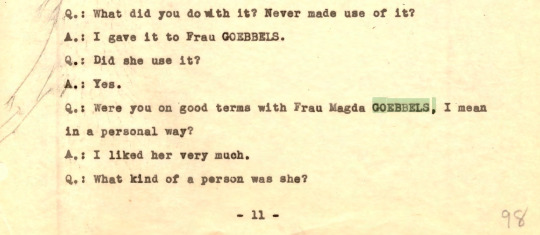

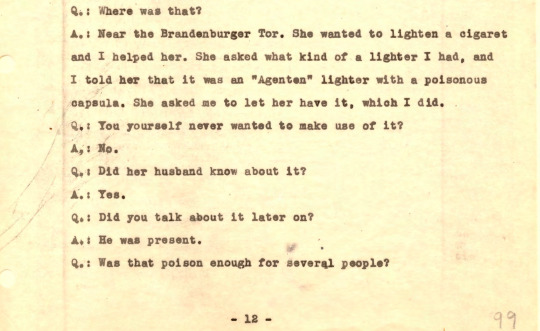
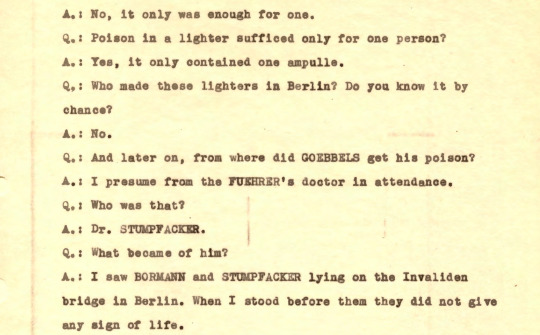

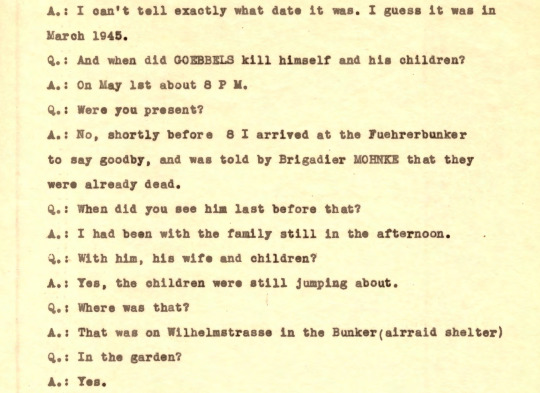

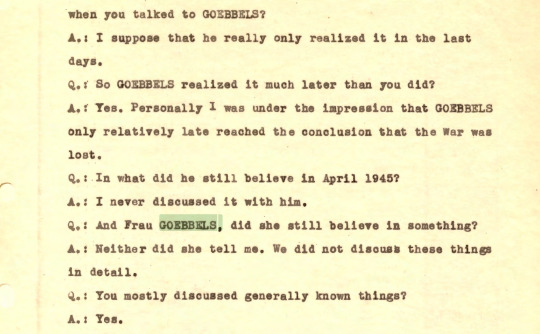
11 notes
·
View notes
Photo

Adolf Hitler - erään miehen ura / Hitler, a Career (1977) Report-Video https://www.videospace.fi/release/adolf_hitler_eraan_miehen_ura_vhs_reportvideo_finland
#Videospace#vhs#Adolf Hitler - erään miehen ura#Hitler#a Career#Joachim Fest#Gert Westphal#Stephen Murray#Artur Axmann#VHS tapes#VHS art#VHS cover
0 notes
Note
Hi! Can I just thank everyone who made watching the stage play possible? You're life savers haha also, was Jitsui's alias Artur Axmann? After a quick search, it says he's a real person who was the leader of Hitler Youth, which Hatano was assigned in (BUT if i remembered the alias wrong, forgive me and dont mind this haha). Speaking of Hitler Youth, research states kids up to 18 were recruited. To think Hatano passed off as a minor.
It would be an awesome idea to thank everyone who made watching the stage play possiblebut, truth to be told, the ones to thank for this are @great-blaster who ended up being the one who translated the whole thing and @szk-niina who was the first to share the raws, not me.
Though I still personally thank all the ones who still attempted to help me create a softsub version before the hardsubbed one was completed. Even though the project ended up being dropped because @great-blaster already made an awesome Joker Game the stage subbed version they’ve still been amazing to try their best to work at it.
As for Jitsui, no, his alias wasn’t Artur Axmann. We don’t know which fake identity he took.
I think what you’re talking about is this sentence.
“Leader Artur Axmannhas connections with Abwehr. He has spoken that it wouldn’t hurt to be cautious.”
This sentence is said by a First Lieutenant in the Hitler Youth (Hatano calls him chūi 中尉“(first) Lieutenant“)). The German correspective should probably be Oberleutnant.
Anyway, when the Lieutenant talks about Leader Artur Axmann, he’s talking of his own leader, the ReichsführerArtur Axmann, which, as you discovered was a real person and the leader of the Hitler Youth and not of Jitsui.
According to the Lieutenant, Axmannhad connections with Abwehr. What does this mean why is this relevant in reference to Jitsui and what was Abwehr?
Starting from the bottom the Abwehr was the German military intelligence service for the Reichswehr and Wehrmacht from 1920 to 1945.
In the anime isn’t said out loud (and I seem to remember the stage didn’t say it out loud either) but our dear Hermann Wolff, who’s investigating on Maki Katsuhiko/Miyoshi’s death, is a member of the Abwehr.
So fundamentally, since Wolff suspects Maki to be a Japanese spy he told Axmann to get rid of all the suspicious Japanese... which is why the Lieutenant wants Jitsui dead and wants Hatano to do the job so as to make sure he’s trustworthy.
And yes, the members of Hitler Youth could be, at most, 18.
Japanese people at the time were often perceived as younger than they were by Europeans due to various issues (they were usually shorter and the difference in physical characteristics as well as the general lack of knowledge on how they looked made harder to recognize their age correctly), so I guess technically it wasn’t that hard for Hatano to pass as younger.
In the stage this isn’t so obvious because, differently from the anime, Hatano is neither the smaller of the cast (he’s taller than Sakuma although he seems shorter than the other spies)...

...nor looks smallerthan the ones playing the role of the Germans (actually he seems taller).

Mind you, although anime Hatano is the shorter among the spies, he actually wasn’t tiny for an average Japanese of that time period, it’s just the other spies who are taller... still looks at the heigh difference between him and the French group, among which he was posing as an university student (and therefore older than 18 though not by many years).

With such a heigh difference for western people who aren’t familiar with Japanese features it would have been easy to be mistaken so yes, he probably could manage to look... let’s say around 17.
So yes, Hatano could probably pull it out but the stage didn’t quite bother to make this believable to viewers, probably because it is common knowledge among Japanese that westerns would view him as younger and therefore didn’t need to be visually depicted.
I hope it helps!
15 notes
·
View notes
Photo
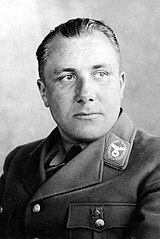
Martin Bormann - jeden z przywódców III Rzeszy, tytularny generał SS – SS-Obergruppenführer w Allgemeine SS. Urodzony w Halberstadt, syn pruskiego sierżanta. Rzucił szkołę, aby pracować na farmie. Po krótkim okresie służby pod koniec I wojny światowej wstąpił do osławionego Freikorpsu Rossbacha. W marcu 1924 trafił na krótko do więzienia za współudział (razem ze swoim przyjacielem Rudolfem Hößem – późniejszym komendantem obozu Auschwitz) w morderstwie politycznym Walthera Kadowa, który prawdopodobnie zadenuncjował Francuzom w Zagłębiu Ruhry Alberta Leo Schlagetera. Po zwolnieniu, od 1925 aktywny działacz NSDAP w Turyngii – pomimo szorstkich manier i braku ogłady rzecznik prasowy, a potem zarządca ekonomiczny. W październiku 1933 mianowany Reichsleiterem NSDAP, a w listopadzie członkiem Reichstagu. Od lipca 1933 szef sztabu Rudolfa Hessa. Po wyjeździe Rudolfa Hessa do Wielkiej Brytanii od maja 1941 roku szef kancelarii NSDAP – na tym stanowisku wykazał duże umiejętności w wewnętrznych walkach politycznych. Rozwinął i zarządzał funduszem przemysłu niemieckiego na rzecz Adolfa Hitlera, w którym gromadził „dobrowolne” wpłaty, przenoszone potem jako dary na prywatne konta wysokich funkcjonariuszy narodowosocjalistycznych. W październiku 1944 został szefem Freikorpsu paramilitarnego – Freikorps Sauerland. Zawsze u boku Hitlera, jako jego zastępca i osobisty sekretarz cieszył się absolutnym zaufaniem Führera, który powtarzał: „Aby wygrać wojnę, potrzebuję Bormanna!”. Podczas ostatnich tygodni wojny przebywał w bunkrze pod Kancelarią Rzeszy, aż do samobójczej śmierci Hitlera (30 kwietnia 1945 roku) i spisał jego ostatni testament. Po raz ostatni Bormann był widziany w nocy z 1 na 2 maja, gdy wraz z Ludwigiem Stumpfegerem usiłował pieszo wydostać się z oblężonego Berlina. Od tej pory jego losy przez wiele lat nie były znane, choć Artur Axmann zeznał, że gdy sam próbował się wydostać z miasta, natknął się na leżące obok siebie ciała Bormanna i Stumpffeggera. Mimo wysiłków alianckich władz zwłok jednak nie odnaleziono. W październiku 1946 roku, w czasie procesu norymberskiego Martin Bormann został zaocznie (in absentia) skazany na karę śmierci. Jeszcze przez dwie dekady donoszono o rzekomym pojawianiu się Bormanna w Europie i Ameryce Południowej, o nieudanej operacji plastycznej, jakiej miał się poddać, a która miała go okaleczyć, a nawet o jego sekretnej współpracy z amerykańskimi, bądź radzieckimi władzami. W grudniu 1972 roku, podczas prac budowlanych w centrum Berlina przy Invalidenstraße (w pobliżu Lehrter Bahnhof) odnaleziono szkielety dwóch mężczyzn. Na podstawie stanu uzębienia i innych cech anatomicznych zostały one formalnie zidentyfikowane przez niemiecki sąd jako szczątki Bormanna i Stumpfeggera. 11 kwietnia 1973 prokurator generalny Horst Gauf poinformował, że zgodnie z ustaleniami niemieckiego wymiaru sprawiedliwości Martin Bormann zginął wczesnym rankiem 2 maja 1945 w trakcie ostatnich walk w Berlinie. Szczątki Bormanna zostały zidentyfikowane i przekazane rodzinie celem pochówku. W czaszkach obu szkieletów znaleziono drobiny szkła po kapsułkach cyjanku, co oznaczałoby, iż obaj popełnili samobójstwo przez zażycie tej trucizny. Badania DNA wykonane w 1998 roku potwierdziły trafność orzeczenia sądu. Rodzina Bormanna nie pozwoliła na pochówek, nie chcąc, aby jego grób stał się obiektem pielgrzymek neonazistów. Kości poddano więc kremacji, a ich prochy zostały rozrzucone przez pierworodnego syna Bormanna na wodach Bałtyku.Martin Bormann był żonaty z Gerdą Buch (córką sędziego najwyższego sądu partyjnego Waltera Bucha) i miał z nią dziewięcioro dzieci. Najstarszy syn – Martin Adolf Bormann – w latach 1958-1969 był katolickim księdzem i misjonarzem.
0 notes
Text
Hitler Had One Last Card To Play to Win World War II (And It Was Awful)
What all of them feared most was a second 1918-style collapse of the German state from within, an internal-type revolt that had toppled Kaiser Wilhelm II when the German Army was still fighting in the field on the Western Front.On October 18, 1944—the 131st anniversary of the Battle of the Nations’ victory over Napoleon in 1813—Reichsführer-SS (National Leader) Heinrich Himmler stepped up to a microphone to make a national radio address announcing the formation of the Nazi Party-controlled Volkssturm, or People’s Militia.Standing with him was the new Chief of the General Staff, General Heinz Guderian; Dr. Hans Heinrich Lammers, head of the Reich Chancellery in Berlin; and Gauleiter (Regional Leader) Erich Koch. The site of the address was at Bartenstein, East Prussia, on Koch’s turf, and he was already organizing his own local forces to fight the Red Army coming from the East.Indeed, conjuring up images of the 1813 War of Liberation against the defeated French, the new VS had already won its first victory over the Soviets on October 7 at Memel, Lithuania, which the Nazis had taken in 1939.Creating the Volkssturm From the Ashes of Operation Valkyrie Guderian had come into office the day after the failed bomb explosion to kill Adolf Hitler, and the latter had virtually lost most of his faith in the regular German armed forces to win the war. The radical Nazis—Dr. Josef Goebbels, Dr. Robert Ley, Himmler, and most of all Reich Leader and Secretary to the Führer Martin Bormann—were urging Hitler to turn to the very force that had brought him to power in the first place: the Nazi Party and its various organizations.Recommended: The 5 Biggest Nuclear Bomb Tests (From All 6 Nuclear Powers).Recommended: How Israel Takes U.S. Weapons and Makes Them Better.Recommended: North Korea’s Most Lethal Weapon Isn’t Nukes.What all of them feared most was a second 1918-style collapse of the German state from within, an internal-type revolt that had toppled Kaiser Wilhelm II when the German Army was still fighting in the field on the Western Front. It was their belief that the Party had rebuilt the state from that catastrophe starting anew in 1933, and now—11 years later—a similar program of rejuvenation was to be the order of the day.This time, there would be no home front failure, and thus on September 25, 1944, Hitler, through the use of his familiar “Führer Decree,” announced the creation of the Volkssturm and Himmler’s control of the organization; Bormann would be in charge of the administrative issues.Thus, right from the start, there was the divided leadership that would plague the VS until the very end of its days in the defense of smoldering Berlin—in which it played at least half a part. Hitler, like his rival, U.S. President Franklin D. Roosevelt, had the leadership style of giving several different men the same functions, believing that competition would make them perform better and get the overall job done faster. This was also the overall leadership principle of the Nazi Party as a whole.Bormann’s VSThe key individual, from inception to ultimate VS demise, was Bormann. In his unique position of being at the Führer’s elbow night and day, he had Hitler’s ear on virtually everything and thus was able to convince Hitler to create the VS along the lines of the 1813 Home Guard, and also to place it under Lammers’s Reich Chancellery. Bormann believed that only the Party could run the VS properly and ensured that service in it was mandatory for all civilian German males between the ages of 16 and 60.This included the all-important Class of 1928—those who would turn 17 in 1945—the 550,000 boys of Artur Axmann’s Hitler Youth, literally the final remaining military manpower pool of Nazi Germany. The older men—ridiculed as “Grandpas” by the younger generation—were veterans of World War I or those who had already fought in World War II and been wounded.The VS would be organized on the model of the 42 Gaue, or Regions, of the Third Reich, all controlled by Bormann as virtual domestic dictator while Hitler ran the war. This had been the setup ever since Germany invaded Poland on September 1, 1939, and thus Bormann understood his task thoroughly, governing the Reich via teleprinter, telegraph, radio, and telephone from wherever Hitler’s “Führer Headquarters” happened to be. He would rule the VS through the Gau, Kreis (county), and Ortsgruppenleiters (town leaders).In Bormann’s mind, the VS would fight like the sturdy Japanese in the Pacific: to the last man, bullet, and breath. The nature of Bormann’s vision for the VS was unity overall, Party control, and formations based on the members’ place of residence. The last factor was all important in his view, as he believed that it was critical to the fighting success of the VS as a combat unit that would be called into action when the enemy arrived at the edges of their towns and cities, most of which had been officially declared “fortresses” by the Führer anyway.The Führer Decree of September 25 gave the Gauleiters the power to organize the VS in their domains, which included more than 800 counties in the Reich proper. The average age of those who served (the national oath-taking was conducted on November 12, 1944) was between 45 and 52, and Bormann—aping Hitler, here–– refused to call up women, unlike the Soviets. Of those men who were called up, most were white-collar workers, unaccustomed to the harsh life of a soldier in the field.Marksmanship vs Antitank WeaponsOn November 27, 1944, Himmler took command of Army Group Upper Rhine, thus making him Bormann’s first serious rival for power, as both wanted to succeed Hitler as Führer. Each reasoned that if they were able to win the war for Germany, they would accede to the mantle, and there was, indeed, some logic in their positions. As it turned out, Himmler’s tenure as commander was brief, as he proved to be completely incompetent in the position.Even though Bormann irritated Himmler by referring to the units as “my VS,” it was a top SS man—General Gottlob Berger—who was chief of staff of the Volkssturm and who reported directly to Himmler, not Bormann. Indeed, it was Berger who announced that the VS would be trained and ready for combat against the Russians and Western Allies no later than March 31, 1945.In training, Berger wanted individual rifle marksmanship stressed for the civilian warriors, while Bormann opted instead for small antitank weapons with which to defeat the masses of Russian T-34s and American M-4 Sherman tanks. In the end, Bormann prevailed, and in this instance his view was militarily sound as events were to prove, especially in the defense of Berlin and other German cities.The citizen-soldiers trained on weeknights and for six hours on Sundays, and what rifle training was provided was given by SA Chief of Staff Wilhelm Schepmann’s brownshirted Stormtroopers. Schepmann had wanted a real wartime role for the SA ever since 1939, and he saw the VS as a way of achieving it at the expense of the SS (its hated rival since 1934), the Party, and the German Army (which it had wanted to replace as early as 1930).Hitler and Bormann, too, saw this danger, and they were not about to let Schepmann achieve an ambition that had eluded the murdered SA leader Captain Ernst Röhm in the Blood Purge of June 30-July 2, 1934. Thus, Schepmann would be allowed to arm and train the VS but not lead it.Nor would Dr. Josef Goebbels in his capacity as Hitler’s appointed Reich Plenipotentiary for Total War. Despite the famous wartime newsreels of the leather-coated propaganda minister reviewing VS troops passing on parade, his role with the Volkssturm was really quite minimal, except for exhorting them to fight for Berlin, of which he was Gauleiter.Then there was the National Socialist Motor Corps led by Erwin Kraus that provided courier motorcyclists and truck drivers to transport the VS men to their sites, as well as units of the Nazi Fliers Korps (NSFK).“Wars Were Winner-Take-All Affairs”It seemed that every Party organization wanted its finger in the VS pie, and for a very simple reason, then and now still incomprehensible to those in the West: the Nazis believed that the war could still be won!First, from Hitler on down, the true Nazis took it as an article of faith that racially pure Germans of good stock would defeat the tainted Slavs from the steppes of Russia and the corrupt Americans, British, and Canadians from the West. Dr. Goebbels’s propaganda screamed its slogans: “Never again, 1918! Our walls may break, but our hearts never!”The citizen-soldiers of the Third Reich—indoctrinated as true believers—would also be fighting for their own homes and families on German soil, and the threat from the East also induced in the Germans of East Prussia the very real fear of Red Army retaliation for the atrocities that had been committed by the Germans in the USSR during 1941-1944.As one historian put it, “Wars were winner-take-all affairs.” To the Nazis, negotiations equaled weakness and surrender. In this respect, Hitler, Bormann, and Goebbels were far more “Nazi” than either or both Himmler and Reich Marshal Hermann Göring, who in the end in 1945 wanted to treat with the enemy.Thus, especially after the failure of the July 20 assassination attempt—when, in their eyes, the traitors had been unmasked—the Nazis wanted to renew—not end—the fighting. It is significant to note that more people in Europe died after July 20, 1944, than in all of the five years of war before it.“Scorched Earth”To the Nazis, the VS was both a valid and rational response to the events of 1944-1945, just as the rise of the Party itself had been to the fall of Imperial Germany in 1918-1920. Indeed, if anyone’s morale would collapse, it would be that of the Allies, not the German people led by the Nazi Party under Hitler.Ironically, too, as the German armies retreated—and this included the battered Waffen SS as well—so, too, did the power of the Party increase within the borders of the pre-1939 Greater German Reich; thus, as Himmler lost power, Bormann gained it.By the spring of 1945, Himmler ceased to be a real factor in VS power struggles and was replaced in these battles by Hitler’s Minister of Armaments and War Production, Albert Speer, who was working hand in glove with the German armed forces—mainly the Regular Army—to prevent the Führer’s decreed “scorched earth” policies designed to make the Third Reich an industrial wasteland of no use to any conquering army.Speer—unlike hardliners Himmler and Göring—was not a true Nazi in the Hitler-Goebbels-Bormann mold and saw for himself a role as the rebuilder of the Fourth Reich under the auspices of the Western Allies at least.The Volkssturm’s Ties to the WehrmachtIn the end, however, Bormann’s concept of the Volkssturm was undone by the very people he wanted to protect it from the most, and from whom he expected the least danger—the officers and men of the German Army in whose sphere of operations the individual VS units fell.The primary reason for this was that the Party simply could not and did not supply the VS with the weapons, uniforms, and supplies that it needed, while the regular military most often did. Wherever the VS and the military worked well together, the morale was good, absenteeism down, discipline maintained, and training heightened. Thus, much to his chagrin, Bormann was faced with a situation in which the Army delivered where the Party had failed.The reason for this, too, was that—unlike the higher ranks of the officer corps, which was, by and large, monarchist in belief and background—the lower ranking officers and most enlisted men were Nazis to the core. To them, the attempt to kill Hitler on July 20, 1944, was a disgrace to the good name of Germany.Indeed, the Army was intimately involved with the Volkssturm from its very beginning. It was the Army that provided both the Panzerfaust (a shoulder-fired rocket similar to the U.S. “bazooka”) and Panzerschreck (“Terror of the Tanks”) antitank weapons that stopped many an enemy tank in its tracks. In the end, the Panzerfausts were the only weapons that were available to the VS in abundant supply for combat.Recognizing the VS as a Legitimate Fighting ForceOne fear that all VS men shared was that, without uniforms, they would simply be shot out of hand by the enemy for being partisans or terrorists behind the lines, particularly if they were confused with Dr. Ley’s proposed postwar Werewolf organization. They also disliked the Party’s brown uniforms, as they feared that Red Army troops would be more likely to kill them and refuse to take them prisoner.Some even served in civilian clothes, overcoats, and hats, with but a Volkssturm armband and a pay book to identify them officially as Volkssturm men. Negotiations were conducted with the Western Allies to recognize the VS as true combatants, and these were successful, but not, significantly, with the Soviets.The VS in CombatIn combat in the East, the VS formations were at the disposal of Guderian (again, ironically), and here they gave a good account of themselves, even halting the Red Army advance at Gumbinnen in East Prussia late in 1944 and elsewhere, but in the West they gave up at places like Remagen when they saw the German Army retreat as well. Here, they served under Field Marshals Gerd von Rundstedt, Walther Model, and Albert Kesselring.VS casualty rates were sometimes as high as 70 to 80 percent, while other units panicked and fled. In the East, some 650,000 VS men saw action, but when Nazi Party officials fled at the approach of the Red Army, so did the VS. When the Army left the VS as rearguard units, not too surprisingly, they returned to their homes rather than die in this manner.In the West, some 150,000 VS men served and had helped to man the West Wall fortifications, as well as hold the Upper Rhine, but in the end, the VS had not achieved Himmler’s or Bormann’s goal. It is estimated that a million VS “troops” were taken prisoner by war’s end, and thousands more were killed and wounded.True, the Volkssturm was a legal militia, not partisan guerrillas, but the Nazis were simply wrong about both their People’s Militia’s motivation and desire to fight to the bitter end, and also their enemies’ sense of moral outrage against Nazism and determination to totally defeat the Third Reich—no matter how long it took or at what cost.This article by Blaine Taylor originally appeared on Warfare History Network. Image: ReutersRecommended: Why North Korea's Air Force is Total Junk Why Doesn't America Kill Kim Jong Un?
from Yahoo News - Latest News & Headlines
What all of them feared most was a second 1918-style collapse of the German state from within, an internal-type revolt that had toppled Kaiser Wilhelm II when the German Army was still fighting in the field on the Western Front.On October 18, 1944—the 131st anniversary of the Battle of the Nations’ victory over Napoleon in 1813—Reichsführer-SS (National Leader) Heinrich Himmler stepped up to a microphone to make a national radio address announcing the formation of the Nazi Party-controlled Volkssturm, or People’s Militia.Standing with him was the new Chief of the General Staff, General Heinz Guderian; Dr. Hans Heinrich Lammers, head of the Reich Chancellery in Berlin; and Gauleiter (Regional Leader) Erich Koch. The site of the address was at Bartenstein, East Prussia, on Koch’s turf, and he was already organizing his own local forces to fight the Red Army coming from the East.Indeed, conjuring up images of the 1813 War of Liberation against the defeated French, the new VS had already won its first victory over the Soviets on October 7 at Memel, Lithuania, which the Nazis had taken in 1939.Creating the Volkssturm From the Ashes of Operation Valkyrie Guderian had come into office the day after the failed bomb explosion to kill Adolf Hitler, and the latter had virtually lost most of his faith in the regular German armed forces to win the war. The radical Nazis—Dr. Josef Goebbels, Dr. Robert Ley, Himmler, and most of all Reich Leader and Secretary to the Führer Martin Bormann—were urging Hitler to turn to the very force that had brought him to power in the first place: the Nazi Party and its various organizations.Recommended: The 5 Biggest Nuclear Bomb Tests (From All 6 Nuclear Powers).Recommended: How Israel Takes U.S. Weapons and Makes Them Better.Recommended: North Korea’s Most Lethal Weapon Isn’t Nukes.What all of them feared most was a second 1918-style collapse of the German state from within, an internal-type revolt that had toppled Kaiser Wilhelm II when the German Army was still fighting in the field on the Western Front. It was their belief that the Party had rebuilt the state from that catastrophe starting anew in 1933, and now—11 years later—a similar program of rejuvenation was to be the order of the day.This time, there would be no home front failure, and thus on September 25, 1944, Hitler, through the use of his familiar “Führer Decree,” announced the creation of the Volkssturm and Himmler’s control of the organization; Bormann would be in charge of the administrative issues.Thus, right from the start, there was the divided leadership that would plague the VS until the very end of its days in the defense of smoldering Berlin—in which it played at least half a part. Hitler, like his rival, U.S. President Franklin D. Roosevelt, had the leadership style of giving several different men the same functions, believing that competition would make them perform better and get the overall job done faster. This was also the overall leadership principle of the Nazi Party as a whole.Bormann’s VSThe key individual, from inception to ultimate VS demise, was Bormann. In his unique position of being at the Führer’s elbow night and day, he had Hitler’s ear on virtually everything and thus was able to convince Hitler to create the VS along the lines of the 1813 Home Guard, and also to place it under Lammers’s Reich Chancellery. Bormann believed that only the Party could run the VS properly and ensured that service in it was mandatory for all civilian German males between the ages of 16 and 60.This included the all-important Class of 1928—those who would turn 17 in 1945—the 550,000 boys of Artur Axmann’s Hitler Youth, literally the final remaining military manpower pool of Nazi Germany. The older men—ridiculed as “Grandpas” by the younger generation—were veterans of World War I or those who had already fought in World War II and been wounded.The VS would be organized on the model of the 42 Gaue, or Regions, of the Third Reich, all controlled by Bormann as virtual domestic dictator while Hitler ran the war. This had been the setup ever since Germany invaded Poland on September 1, 1939, and thus Bormann understood his task thoroughly, governing the Reich via teleprinter, telegraph, radio, and telephone from wherever Hitler’s “Führer Headquarters” happened to be. He would rule the VS through the Gau, Kreis (county), and Ortsgruppenleiters (town leaders).In Bormann’s mind, the VS would fight like the sturdy Japanese in the Pacific: to the last man, bullet, and breath. The nature of Bormann’s vision for the VS was unity overall, Party control, and formations based on the members’ place of residence. The last factor was all important in his view, as he believed that it was critical to the fighting success of the VS as a combat unit that would be called into action when the enemy arrived at the edges of their towns and cities, most of which had been officially declared “fortresses” by the Führer anyway.The Führer Decree of September 25 gave the Gauleiters the power to organize the VS in their domains, which included more than 800 counties in the Reich proper. The average age of those who served (the national oath-taking was conducted on November 12, 1944) was between 45 and 52, and Bormann—aping Hitler, here–– refused to call up women, unlike the Soviets. Of those men who were called up, most were white-collar workers, unaccustomed to the harsh life of a soldier in the field.Marksmanship vs Antitank WeaponsOn November 27, 1944, Himmler took command of Army Group Upper Rhine, thus making him Bormann’s first serious rival for power, as both wanted to succeed Hitler as Führer. Each reasoned that if they were able to win the war for Germany, they would accede to the mantle, and there was, indeed, some logic in their positions. As it turned out, Himmler’s tenure as commander was brief, as he proved to be completely incompetent in the position.Even though Bormann irritated Himmler by referring to the units as “my VS,” it was a top SS man—General Gottlob Berger—who was chief of staff of the Volkssturm and who reported directly to Himmler, not Bormann. Indeed, it was Berger who announced that the VS would be trained and ready for combat against the Russians and Western Allies no later than March 31, 1945.In training, Berger wanted individual rifle marksmanship stressed for the civilian warriors, while Bormann opted instead for small antitank weapons with which to defeat the masses of Russian T-34s and American M-4 Sherman tanks. In the end, Bormann prevailed, and in this instance his view was militarily sound as events were to prove, especially in the defense of Berlin and other German cities.The citizen-soldiers trained on weeknights and for six hours on Sundays, and what rifle training was provided was given by SA Chief of Staff Wilhelm Schepmann’s brownshirted Stormtroopers. Schepmann had wanted a real wartime role for the SA ever since 1939, and he saw the VS as a way of achieving it at the expense of the SS (its hated rival since 1934), the Party, and the German Army (which it had wanted to replace as early as 1930).Hitler and Bormann, too, saw this danger, and they were not about to let Schepmann achieve an ambition that had eluded the murdered SA leader Captain Ernst Röhm in the Blood Purge of June 30-July 2, 1934. Thus, Schepmann would be allowed to arm and train the VS but not lead it.Nor would Dr. Josef Goebbels in his capacity as Hitler’s appointed Reich Plenipotentiary for Total War. Despite the famous wartime newsreels of the leather-coated propaganda minister reviewing VS troops passing on parade, his role with the Volkssturm was really quite minimal, except for exhorting them to fight for Berlin, of which he was Gauleiter.Then there was the National Socialist Motor Corps led by Erwin Kraus that provided courier motorcyclists and truck drivers to transport the VS men to their sites, as well as units of the Nazi Fliers Korps (NSFK).“Wars Were Winner-Take-All Affairs”It seemed that every Party organization wanted its finger in the VS pie, and for a very simple reason, then and now still incomprehensible to those in the West: the Nazis believed that the war could still be won!First, from Hitler on down, the true Nazis took it as an article of faith that racially pure Germans of good stock would defeat the tainted Slavs from the steppes of Russia and the corrupt Americans, British, and Canadians from the West. Dr. Goebbels’s propaganda screamed its slogans: “Never again, 1918! Our walls may break, but our hearts never!”The citizen-soldiers of the Third Reich—indoctrinated as true believers—would also be fighting for their own homes and families on German soil, and the threat from the East also induced in the Germans of East Prussia the very real fear of Red Army retaliation for the atrocities that had been committed by the Germans in the USSR during 1941-1944.As one historian put it, “Wars were winner-take-all affairs.” To the Nazis, negotiations equaled weakness and surrender. In this respect, Hitler, Bormann, and Goebbels were far more “Nazi” than either or both Himmler and Reich Marshal Hermann Göring, who in the end in 1945 wanted to treat with the enemy.Thus, especially after the failure of the July 20 assassination attempt—when, in their eyes, the traitors had been unmasked—the Nazis wanted to renew—not end—the fighting. It is significant to note that more people in Europe died after July 20, 1944, than in all of the five years of war before it.“Scorched Earth”To the Nazis, the VS was both a valid and rational response to the events of 1944-1945, just as the rise of the Party itself had been to the fall of Imperial Germany in 1918-1920. Indeed, if anyone’s morale would collapse, it would be that of the Allies, not the German people led by the Nazi Party under Hitler.Ironically, too, as the German armies retreated—and this included the battered Waffen SS as well—so, too, did the power of the Party increase within the borders of the pre-1939 Greater German Reich; thus, as Himmler lost power, Bormann gained it.By the spring of 1945, Himmler ceased to be a real factor in VS power struggles and was replaced in these battles by Hitler’s Minister of Armaments and War Production, Albert Speer, who was working hand in glove with the German armed forces—mainly the Regular Army—to prevent the Führer’s decreed “scorched earth” policies designed to make the Third Reich an industrial wasteland of no use to any conquering army.Speer—unlike hardliners Himmler and Göring—was not a true Nazi in the Hitler-Goebbels-Bormann mold and saw for himself a role as the rebuilder of the Fourth Reich under the auspices of the Western Allies at least.The Volkssturm’s Ties to the WehrmachtIn the end, however, Bormann’s concept of the Volkssturm was undone by the very people he wanted to protect it from the most, and from whom he expected the least danger—the officers and men of the German Army in whose sphere of operations the individual VS units fell.The primary reason for this was that the Party simply could not and did not supply the VS with the weapons, uniforms, and supplies that it needed, while the regular military most often did. Wherever the VS and the military worked well together, the morale was good, absenteeism down, discipline maintained, and training heightened. Thus, much to his chagrin, Bormann was faced with a situation in which the Army delivered where the Party had failed.The reason for this, too, was that—unlike the higher ranks of the officer corps, which was, by and large, monarchist in belief and background—the lower ranking officers and most enlisted men were Nazis to the core. To them, the attempt to kill Hitler on July 20, 1944, was a disgrace to the good name of Germany.Indeed, the Army was intimately involved with the Volkssturm from its very beginning. It was the Army that provided both the Panzerfaust (a shoulder-fired rocket similar to the U.S. “bazooka”) and Panzerschreck (“Terror of the Tanks”) antitank weapons that stopped many an enemy tank in its tracks. In the end, the Panzerfausts were the only weapons that were available to the VS in abundant supply for combat.Recognizing the VS as a Legitimate Fighting ForceOne fear that all VS men shared was that, without uniforms, they would simply be shot out of hand by the enemy for being partisans or terrorists behind the lines, particularly if they were confused with Dr. Ley’s proposed postwar Werewolf organization. They also disliked the Party’s brown uniforms, as they feared that Red Army troops would be more likely to kill them and refuse to take them prisoner.Some even served in civilian clothes, overcoats, and hats, with but a Volkssturm armband and a pay book to identify them officially as Volkssturm men. Negotiations were conducted with the Western Allies to recognize the VS as true combatants, and these were successful, but not, significantly, with the Soviets.The VS in CombatIn combat in the East, the VS formations were at the disposal of Guderian (again, ironically), and here they gave a good account of themselves, even halting the Red Army advance at Gumbinnen in East Prussia late in 1944 and elsewhere, but in the West they gave up at places like Remagen when they saw the German Army retreat as well. Here, they served under Field Marshals Gerd von Rundstedt, Walther Model, and Albert Kesselring.VS casualty rates were sometimes as high as 70 to 80 percent, while other units panicked and fled. In the East, some 650,000 VS men saw action, but when Nazi Party officials fled at the approach of the Red Army, so did the VS. When the Army left the VS as rearguard units, not too surprisingly, they returned to their homes rather than die in this manner.In the West, some 150,000 VS men served and had helped to man the West Wall fortifications, as well as hold the Upper Rhine, but in the end, the VS had not achieved Himmler’s or Bormann’s goal. It is estimated that a million VS “troops” were taken prisoner by war’s end, and thousands more were killed and wounded.True, the Volkssturm was a legal militia, not partisan guerrillas, but the Nazis were simply wrong about both their People’s Militia’s motivation and desire to fight to the bitter end, and also their enemies’ sense of moral outrage against Nazism and determination to totally defeat the Third Reich—no matter how long it took or at what cost.This article by Blaine Taylor originally appeared on Warfare History Network. Image: ReutersRecommended: Why North Korea's Air Force is Total Junk Why Doesn't America Kill Kim Jong Un?
September 01, 2019 at 08:47AM
via IFTTT
0 notes
Photo




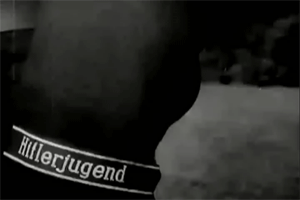
Reichsjugendführer (leader of the Hitler Youth) Artur Axmann presenting the “HitlerJugend” cuff-title to personnel of the 26th Panzergrenadier Regiment on September 19, 1944, Kaiserslautern, Germany.
Many of the Hitlerjugend´s NCOs and officers came from the 1st SS Leibstandarte Adolf Hitler Division, forming a tough backbone in the new formed 12th SS Panzer Division Hitlerjugend.
#ww2#wwii#history#artur axmann#hitlerjugend#12th SS Panzer Division Hitlerjugend#1st SS Division Leibstandarte SS Adolf Hitler#Leibstandarte#Division Leibstandarte#Leibstandarte SS Adolf Hitler#hitler youth#Hitler Jugend
361 notes
·
View notes
Text
Death of Adolf Hitler - Part 11: The Breakout by Martin Bormann
Death of Adolf Hitler – Part 11: The Breakout by Martin Bormann
.
. By T.V. Antony Raj
.
On May 1, 1945, around 11:00 pm, Martin Bormann left the Führerbunker in one of the ten breakout groups that included Adolf Hitler’s personal surgeon Ludwig Stumpfegger, Hitler Youth leader Artur Axmann, Hitler’s pilot Hans Baur, Erich Kempka and Werner Naumann, State Secretary in Joseph Goebbels’ Ministry of Public Enlightenment and Propaganda.
View On WordPress
#WPLongform#Adolf Hitler#Armin Lehmann#Artur Axmann#Battle of Berlin#Berlin#breakout#Erich Kempka#Führer#Führerbunker#Food for Thought#Franz Schädle#Georg Betz#German#GERMANY#Hans Baur#Hans Krebs#Helmuth Weidling#Hitler#Johannes Hentschel#Ludwig Stumpfegger#Martin Bormann#postaday#Reich Chancellery#Rochus Misch#This is life#Traudl Junge#tvaraj#Wilhelm Burgdorf#Wilhelm Mohnke
0 notes
Text
Death of Adolf Hitler - Part 10: The Breakout from the Reichskanzlei-Führerbunker
Death of Adolf Hitler – Part 10: The Breakout from the Reichskanzlei-Führerbunker
.
. By T.V. Antony Raj
.
General Helmuth Weidling, defense commandant of Berlin.
Although Hitler had appointed General Helmuth Weidling as defense commandant of Berlin, SS-Brigadeführer Wilhelm Mohnke remained free of Weidling’s command to maintain his defense objectives of the Reich Chancellery and the Führerbunker. The aggregated total for the Berlin’s defense of General Weidling’s LVI…
View On WordPress
#WPLongform#Adolf Hitler#Armin Lehmann#Artur Axmann#Battle of Berlin#Berlin#breakout#Erich Kempka#Führer#Führerbunker#Food for Thought#Franz Schädle#Georg Betz#German#GERMANY#Hans Krebs#Helmuth Weidling#Hitler#Johannes Hentschel#Ludwig Stumpfegger#Martin Bormann#postaday#Rochus Misch#This is life#Traudl Junge#tvaraj#Wilhelm Burgdorf#Wilhelm Mohnke#World War II
0 notes